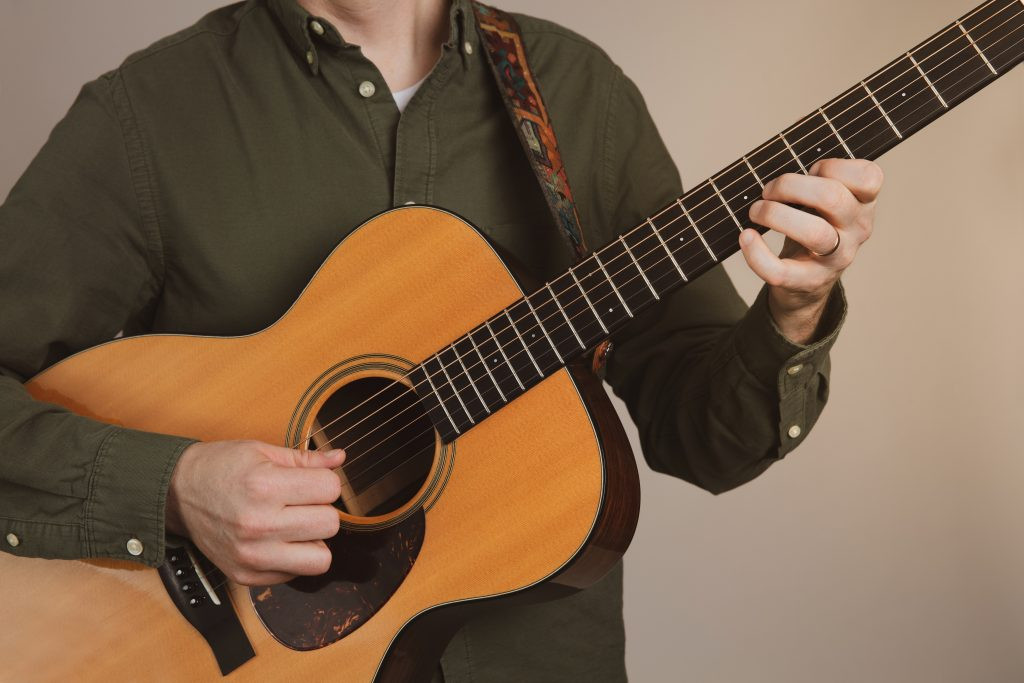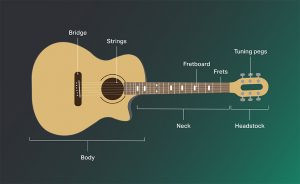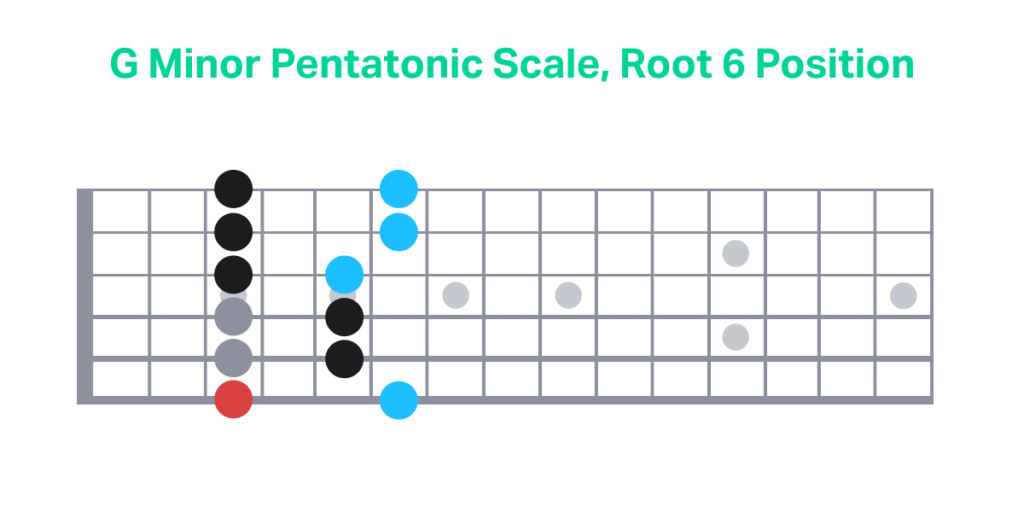Have you ever dreamt of strumming your favorite tunes on a guitar? Maybe you just want a relaxing hobby, or perhaps you envision yourself on a grand stage someday. Whatever your aspirations, learning guitar is a fantastic journey, and taking the first step is something to be proud of. You’ve landed in the right place to begin!
Consider this your starting point toward becoming the guitarist you’ve always wanted to be. At guitarplayers.net, we’re dedicated to providing you with the resources you need to learn and grow. Throughout this guide, we’ll link to more in-depth articles on our site to further enhance your learning experience. Let’s dive in and get you playing!
1. Acoustic vs. Electric Guitar: Which is Right for You?
The first major decision on your guitar journey is choosing between an acoustic and an electric guitar. Both are excellent starting points, and we have detailed guides on acoustic guitars and electric guitars to help you decide.
 Acoustic and Electric Guitars
Acoustic and Electric Guitars
Acoustic Guitars: Simple and Accessible
Acoustic guitars are often recommended for beginners due to their simplicity and affordability. A nylon-string acoustic guitar is particularly gentle on new fingers and is a very accessible entry point. While budget-friendly options are available, investing in a good quality acoustic guitar is wise. A better instrument will not only sound nicer but also be more enjoyable to play and last as your skills progress.
 Playing Acoustic Guitar
Playing Acoustic Guitar
Electric Guitars: Versatile and Powerful
Electric guitars generally come with a higher price tag than acoustics but offer greater versatility, especially if you’re drawn to genres like rock and blues. Starting with an electric guitar is perfectly viable, particularly if you’re eager to explore beyond basic chords. Just remember that an electric guitar requires additional equipment like an amplifier and potentially a distortion pedal to achieve that classic rock sound.
2. Getting Familiar with Guitar Anatomy
To effectively learn guitar, knowing the names of its parts is essential. Understanding guitar parts will help you follow instructions and communicate with other musicians. Key components include:
- Body
- Fretboard
- Frets
- Neck
- Headstock
- Strings
- Tuning Pegs
 Guitar Parts Diagram
Guitar Parts Diagram
The specific features can vary between acoustic and electric guitars. For example, acoustic guitars typically have a soundhole for resonance, while electric guitars are equipped with pickups, knobs, and input jacks for amplification and tone control.
3. The Correct Way to Hold Your Guitar
Whether you choose an electric or acoustic guitar, proper posture is crucial for comfortable playing and preventing injuries. Your preferred playing style will also influence how to hold the guitar. Acoustic guitarists often sit down and rest the guitar on their lap, typically on either the left or right leg.
While electric guitars can also be played seated, many players prefer to stand, particularly when performing. In this case, a guitar strap is necessary to support the instrument.
 Proper Guitar Posture
Proper Guitar Posture
When holding the guitar, ensure the thickest string (low E string) is closest to your body when you look down. The hand that presses down on the strings on the neck is called the “fretting hand,” and the other hand, usually the right for right-handed players, is the “picking hand” or “strumming hand.” Left-handed guitarists reverse this.
For left-handed individuals, options include playing a standard right-handed guitar as is, flipping a right-handed guitar and playing “upside down,” or using a dedicated left-handed guitar.
4. Understanding Guitar Strings and the Fretboard
The fretboard and strings are fundamental to playing guitar. The strings, from thickest to thinnest (lowest to highest pitch), are named E, A, D, G, B, and E. The low E string is the one closest to you when holding the guitar. Pressing strings down onto the fretboard, known as “fretting,” can be uncomfortable initially. However, with practice, your fingertips will toughen up and become more resilient.
Nylon strings are gentler on the fingers compared to steel strings, making them ideal for beginners. To produce a clear sound, ensure you press the strings firmly just behind the metal fret, not directly on top of it.
5. Tuning Your Guitar to Standard Pitch
Playing a guitar that’s out of tune can be discouraging and hinder your learning. Therefore, learning to tune your instrument is a crucial early step. For beginners, standard EADGBE tuning is the primary focus, and you don’t need to worry about alternate guitar tunings just yet. EADGBE refers to the standard tuning of the six guitar strings, from the lowest (thickest) to the highest (thinnest).
 Guitar Tuning
Guitar Tuning
Electronic tuners simplify the tuning process for both acoustic and electric guitars. However, the most convenient and cost-effective method is using a free online guitar tuner app, such as GuitarTuna. These apps are readily available on your smartphone, eliminating the need for extra equipment.
6. Mastering Basic Guitar Chords
Before attempting complex solos, start with the foundation: basic guitar chords. Familiarize yourself with guitar chord charts, which visually represent chord shapes. Begin by learning fundamental open chords, often called “cowboy chords.” These chords are categorized into major and minor chords.
If you ever forget a chord shape, our comprehensive guitar chord charts library is always available for reference.
Major Chords: Bright and Happy Sounds
Starting slowly is key when learning guitar. Learning just a few basic chords opens up the ability to play countless songs! Excellent starting major chords include A, D, C, and E. Here’s a chord chart example for the E major chord:
(Ideally, a chord chart image for E Major would be here, but text description is provided in original article context)
Minor Chords: Dark and Melancholic Tones
Great minor chords for beginners are A minor (Am) and E minor (Em). Minor chords are denoted with a lowercase “m.” Here’s how to play the E minor chord:
 E Minor Chord Chart
E Minor Chord Chart
Major and minor chords are distinguished by their sound: minor chords have a darker, sadder quality, while major chords sound brighter and happier.
7. Strumming Guitar Chords Rhythmically
Playing chords involves strumming multiple strings simultaneously. However, some chords, like D and C, require you to avoid strumming certain strings. This is why some chords are initially easier to play than others. Besides avoiding certain strings, be mindful of not accidentally muting any strings with your strumming hand.
Once you’re comfortable strumming basic open chords, experiment with upstrokes and downstrokes, and explore more intricate strumming patterns and chord progressions. You can also challenge yourself with different chord types, including barre chords, which require pressing down multiple strings with a single finger.
8. Reading Guitar Tablature (Tabs)
When you want to play melodies and riffs beyond just chords, guitar tablatures, or “tabs,” become invaluable. Guitar tabs are a simplified way to read music notation for guitar. They represent strings as horizontal lines, and numbers on these lines indicate which fret to play. ‘0’ represents an open string, and ‘X’ indicates a muted string. The bottom line is the low E string, and the top line is the high E string.
Tabs can also represent chords, but their true power lies in showing techniques like slides, bends, hammer-ons, pull-offs, and more. These techniques might be advanced for absolute beginners, but learning to read tabs opens up a world of musical possibilities as you progress.
9. Picking and Using a Guitar Pick (Plectrum)
While fingerpicking individual notes is possible using your fingers, a guitar pick (plectrum) is extremely useful, especially for electric guitar and for strumming acoustic guitar with more attack and volume. Picks come in various shapes, sizes, and materials, but thickness is the most crucial factor.
 Guitar Pick
Guitar Pick
To pick individual strings, hold the pick between your thumb and index finger, keeping your other fingers relaxed. Let a small portion of the pick protrude from your thumb, with your thumb’s nail facing upwards. Start by picking individual strings slowly, then gradually increase speed, practicing both upstrokes and downstrokes. Don’t worry about initial mistakes; accuracy will improve with practice.
10. Exploring Minor and Major Scales
Guitar scales and music theory can seem daunting initially. However, scales are excellent tools for exploring the fretboard and understanding note relationships. They are also fundamental for improvisation and songwriting. Like chords, scales come in major and minor forms.
 G Minor Pentatonic Scale Chart
G Minor Pentatonic Scale Chart
Yousician offers interactive exercises to help you master various guitar scales. Practicing scales ascending and descending is an effective way to memorize them. As your finger dexterity improves, gradually increase your playing speed.
11. Playing Your Favorite Songs: The Fun Begins!
Now for the most exciting part: playing songs you love! Forget bulky songbooks; the internet provides guitar tabs and chords for virtually any song imaginable. Simply search online for “[song title] tab” to likely find a guitar tablature version.
Beyond standard tabs and chords, interactive music learning apps like Yousician offer another engaging way to learn songs. Explore Yousician’s extensive song library spanning diverse artists, bands, and genres – your favorite song might be waiting for you!
12. The Golden Rule: Practice Consistently
Once you grasp basic chords, tuning, fretboard navigation, and tab reading, consistent practice is paramount. Make guitar practice a daily habit. While your fingertips might be sore initially, your hands will adapt, building finger strength and muscle memory.
 Woman Practicing Guitar
Woman Practicing Guitar
Learn Guitar Basics with Yousician!
Remember, while practice is crucial, enjoyment is equally important. Learning should be fun and motivating. This is where Yousician excels.
Yousician acts as your personalized guitar tutor, guiding you through interactive lessons at your own pace. Its song library provides hundreds of popular songs to learn and play. Yousician offers real-time feedback, making practice sessions engaging and motivating, encouraging continuous improvement.
Download Yousician on your computer or mobile device and embark on your musical journey today!
Frequently Asked Questions for Beginner Guitarists
Starting guitar can bring up many questions. Here are some encouraging answers for aspiring players:
How Long Does Learning Guitar Take?
The learning timeline varies greatly. Practice frequency, practice quality, and individual aptitude all play a role. Prior musical experience can also be beneficial.
Consistent practice is key to progress. With dedication, you can move beyond the beginner stage within months and reach an intermediate level in one to three years. Mastery is a lifelong pursuit, offering continuous learning and growth.
How Often Should I Practice Guitar?
Aim for 15-30 minutes of focused practice most days as a beginner. If you’re enjoying it and have more time, feel free to practice longer! Don’t be discouraged by occasional missed days; consistency over time is what matters. Focus during practice sessions and minimize distractions to maximize your progress – while still having fun!
Do I Need Music Theory to Play Guitar?
While you can play guitar without in-depth music theory knowledge, understanding some basics will accelerate your progress and deepen your musical appreciation. Music theory can also help you learn new songs faster. However, don’t let music theory be a barrier if your primary goal is simply to enjoy playing your favorite songs.
How Can I Learn Guitar at Home Effectively?
Starting from scratch can feel overwhelming. Guidance and encouragement are invaluable. Learning guitar at home is easier than ever with online lessons and interactive apps. These resources provide structure and support, even without a physical teacher.
Can I Teach Myself Guitar?
Many iconic guitarists, like Jimi Hendrix and Eric Clapton, were self-taught! Self-learning is now more accessible than ever due to online resources and technology. With apps and readily available resources, you can successfully learn guitar at home and become proficient.
Ready to Play?
Play the songs you love with Yousician. Try Premium+ free for 7 days.
Start your free trial
